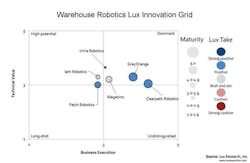Will warehouse robotics replace or enhance humans?
Boston, MA. Rapidly expanding e-commerce and generous funding from eager investors have led to the emergence of a stream of warehouse robotics startups and two broad technologies—those to replace humans and those that assist humans in tedious logistic tasks. There is little technical differentiation between the two approaches today, but human-assisting technologies will prosper in the near term while human-replacement technologies become more important in the long term, according to Lux Research.
“The holy grail of warehouse automation solutions is a product portfolio that can remove people from tedious logistic tasks, such as inventory tracking, product picking, and material transport,” said Kyle Landry, Lux Research associate and lead author of the report titled “Warehouse Robotics: Assistive Tools, or Replacements for Humans?”
“The flow of startups entering the space will continue, and as deployments increase, the two types of technology companies will find their way into appropriate logistics roles,” he added.
Lux Research analysts evaluated warehouse robotics startups on the Lux Innovation Grid, analyzing their technical and business strengths, and delivered an overall rating, called the Lux Take. Among their findings:
- Early human-assisting robots gain traction. ClearpathRobotics and GreyOrange earned their “Dominant” ratings not because of top technical ratings but because of their focus on general-purpose mobile robot platforms and for being the first to market. Both have established partnerships and a strong customer base to earn high business execution scores.
- InViaRobotics gets highest technical score. Leveraging the founders’ extensive computer vision backgrounds into the development of a human-replacement robotic picking solution, inViaRobotics topped startups in technical score. The company is in early customer trials with LD Products to pick printer cartridges and office supplies.
- Fetch addresses broader market. Despite being an assistive technology company, Fetch Robotics has a low business execution value because it is still in the process of building partnerships and establishing its sales pipeline. It still earned a “Positive” Lux Take because its technology can be customized to add operation-specific hardware.
The report, titled “Warehouse Robotics: Assistive Tools or Replacements for Humans?” is part of the Lux Research Autonomous Systems 2.0 Intelligence service.
About the Author

Rick Nelson
Contributing Editor
Rick is currently Contributing Technical Editor. He was Executive Editor for EE in 2011-2018. Previously he served on several publications, including EDN and Vision Systems Design, and has received awards for signed editorials from the American Society of Business Publication Editors. He began as a design engineer at General Electric and Litton Industries and earned a BSEE degree from Penn State.

